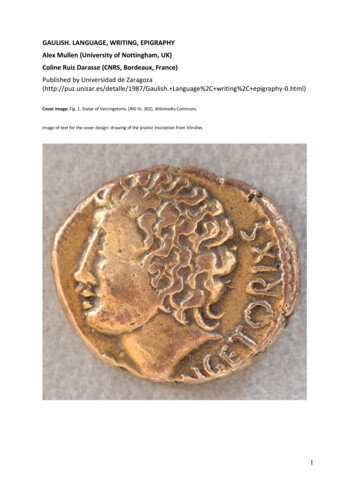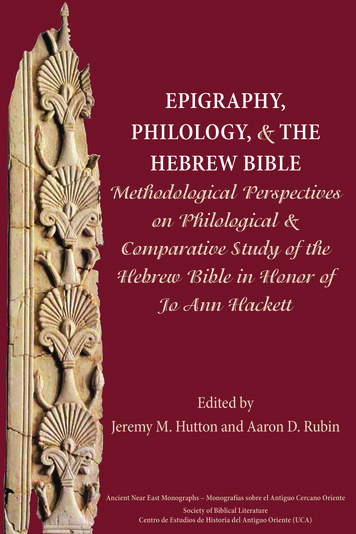
Transcription
GAULISH. LANGUAGE, WRITING, EPIGRAPHYAlex Mullen (University of Nottingham, UK)Coline Ruiz Darasse (CNRS, Bordeaux, France)Published by Universidad de . Language%2C writing%2C epigraphy-0.html)Cover image: Fig. 1. Stater of Vercingetorix. (RIG IV, 302), Wikimedia CommonsImage of text for the cover design: drawing of the praitor inscription from Vitrolles1
Map 1. The Celtic epigraphic zones.This map indicates the key zones of the Continental Celtic epigraphies: Celtiberian, Cisalpine Gaulish, GalloGreek, Gallo-Latin, Lepontic, which are all related languages, but which are attested in different geographicalareas and using different scripts.2
Introduction*Language is important in both individual and group identities. In understanding the Iron Ageand Roman worlds and their developments, we must strive to incorporate an appreciation ofthe local languages and their communities. Unfortunately a key ancient language such asGaulish is generally only studied by specialist linguists, and many classical scholars, forexample, have little knowledge of it. We have written a text which is designed to reveal thecomplexity and importance of the Gaulish language to a wider audience.Linguists classify Gaulish as a Continental Celtic language and a member of the Celtic branchof the vast Indo-European family tree. It was spoken and written principally in Gaul, an areawhich covers, at its greatest extent, modern day France, Belgium, Luxembourg, most ofSwitzerland, Northern Italy, and parts of the Netherlands and Germany. One of the mostfamous quotations from Antiquity, from the opening of Caesar’s De bello Gallico, tells us thatGaul was ‘divided into three parts’, the Tres Galliae, but naturally Caesar was focusing on hisarea of interest: Gaul on the eve of the Gallic Wars which included Gallia Belgica, GalliaCeltica/Lugdunensis and Gallia Aquitania. We could also add Gallia Cisalpina, Gaul-on-theRoman-side-of-the-Alps, i.e. northern Italy, the earliest of the Galliae to be brought underRoman control, though this was incorporated into Italia in the first century BC, and we mustinclude Gallia Narbonensis, which had earlier been called Transalpine Gaul, Gaul-on-theother-side-of-the-Alps. Gaulish is commonly used to refer to Celtic spoken in Gaul on thenon-Italian side of the Alps, in the Tres Galliae and Gallia Narbonensis. Cisalpine Gaul alsocontains Celtic inscriptions, which are sometimes grouped together and called ‘Italo-Celtic’.These include early evidence of an apparently Celtic language called ‘Lepontic’ written in anEtruscan script around the great lakes in Northern Italy and a number of later inscriptionsalso in a form of the Etruscan script attested to the south of this area. Many linguistsconsider the latter group to be Gaulish, and they are often called ‘Cisalpine Gaulish’ or GalloEtruscan (note that sadly the census in RIG is now out-dated). This survey will focus on theCeltic of Gaul beyond the Alps which is written largely in Latin and Greek script. AnotherAELAW booklet will treat Italo-Celtic.Figs. 1–3. Bronze vessel and Gaulish inscription from Couchey (II.2 L-133).This beautiful Gaulish inscription in Latin capitals is neatly inscribed into the handle of the bronze vessel. It wasfound by agricultural workers in the mid-19th century not far from Alesia (Côte d’Or) in the commune ofCouchey. It reads: DOIROS SEGOMARI / IEVRV ALISANV ‘Doiros son of Segomaros made this for the god ofAlesia’. The object can be compared to a very similar one with a Latin dedication to the same deity deo Alisanofrom the nearby commune of Viévy (Corpus inscriptionum Latinarum XIII 2843).*References in this text to Gaulish inscriptions are to the main corpus for Gaulish, Recueil des inscriptionsgauloises (RIG), unless stated otherwise. The references are in the format: for RIG I – I G-X, for RIG II.1 – II.1 LX, for RIG II.2 – II.2 L-X.3
This Gaulish world should not be seen as a homogeneous ‘nation’, rather it was composed ofdozens of complex, fractious and migrant ‘tribes’, whose names have largely beentransmitted to us by the Roman elite, for example in the first-century BC accounts of Caesar.These Roman texts may well have misrepresented (deliberately or not), and fixed in time,some of the tribal groupings; their precise composition and interaction are still not fullyunderstood and require interpretation of archaeological remains in combination withepigraphic and literary testimonies. Probably the concept ‘Gaul’ did not mean much to itsinhabitants. The archaeological remains indicate a high degree of regional variation in theso-called ‘La Tène’ material culture (named after the famous site in Switzerland, a labelwhich links it to material culture found in many other parts of the ancient world from theIberian peninsula to eastern Europe and which has sometimes unquestioningly been linkedto the language family and named ‘Celtic’). The question whether language unified this areamust be approached with caution: the fact that linguists call Gaulish ‘Celtic’ should not leadus blindly down the anachronistic view of ‘one language, one nation’. Speakers of Celticlanguages might have understood one another more easily than they did speakers of nonCeltic languages such as Iberian, but we should not automatically assume any deeper links.Many dialectal variants across Gaul may have mapped onto local identities which we cannotcapture. Indeed, groups in northern Gaul may have been closer linguistically and culturally tothose of southern Britain than to those of southern Gaul and we know of historicallyattested migrations across the Channel.Fig. 3. A Gaulish name written in north-eastern Iberian script found in Ensérune (Hérault, France).Ensérune is a site in south-western Gaul, close to Béziers, which was occupied from the sixth century BC. It hasproduced several hundred inscriptions in a north-eastern variant of the Iberian script which indicate closecontacts between the Celtic and Iberian-speaking worlds. This inscription on an Attic vase from the necropolis(IV c. BC) can be transcribed: ọṣ́ịobaŕenḿi. It shows the adaptation of a probable Oxiomaros followed by twoIberian suffixes (-en and-ḿi) probably indicating possession.The popularity of certain historical figures, for example Vercingetorix, or fictional ones, suchas Asterix, illustrates the importance of the construction of the character of the Gaul in bothancient and modern culture. Obsession with the Gaulish world in France was rife during theSecond Empire and Third Republic, with the famous ‘Nos ancêtres les Gaulois’ which began4
History lessons, and facilitated growth in Celtic studies. For some time, notably as a result ofa famous passage in Caesar’s Gallic Wars (6.14), in which he explains that Druids do notcommit their learning to writing, it was generally assumed that Gauls did not write (thoughthe passage also states that they use ‘Greek letters’ for public and private matters).Archaeological finds soon demonstrated that Gaulish-speaking communities used severalscripts, principally Latin and Greek, for their own language within Gaul, as well as a variant ofthe Etruscan script in Cisalpine Gaul, and Iberian in south-western Gaul if only, it seems, towrite their names. We now have several hundred inscriptions in Gaulish, a total which isgrowing all the time, and these are an essential guide to understanding the language andcommunities since they are not, this time, the product of external sources.Fig. 4. Gallo-Latin inscription from Auxey (II.1 L-9).This inscribed stone was found during agricultural work at the end of the eighteenth century at Auxey (Côted’Or) and according to an unverifiable tradition was found serving as a lid to a burial. Given that the text is adedication to a deity, if the tradition is correct, it must have been reused in antiquity. It probably dates to thefirst or early second century AD.Before our epichoric epigraphic sources built up substantially, studies of Gaulish reliedheavily on names of persons and places, transmitted through a range of sources, includingmedieval documents, classical texts and epigraphy. This output includes the nineteenthcentury work of Henri d’Arbois de Jubainville and Holder and later volumes by Evans (1967)and Schmidt (1957), updated by Delamarre (2007). Delamarre’s Dictionnaire de la languegauloise offers a comprehensive compendium of Gaulish words from all sources, includingthose found in the Latin and French languages, examples transmitted by medieval glossaries,and from the epigraphic record. The first descriptive volume on the Gaulish language basedon epigraphy was that of Dottin (1918), now replaced by Lambert (2003). From the 1980sthe Recueil des inscriptions gauloises (RIG) has been presenting the inscriptions for theacademic community: Gallo-Greek in RIG I, 1985; Gallo-Latin on stone RIG II.1, 1988; GalloLatin on other materials RIG II.2, 2002; Gallo-Latin calendars RIG III, 1986; coin legends RIGIV, 1998.5
LanguageGaulish belongs to the Celtic branch of the Indo-European family tree, in a group, forgeographical reasons, called Continental Celtic, along with Celtiberian in Spain and ItaloCeltic (Lepontic and Cisalpine Gaulish) in northern Italy. Celtic languages show distinctivedevelopments from their Indo-European roots, for example loss of Indo-European */p/ andthe development of Indo-European */gw/ into /b/. We do not have enough continuouswritten Gaulish to be able to reconstruct the language completely, but we can use ourknowledge of Indo-European linguistics, and especially our understanding of the InsularCeltic languages, some of which are still spoken today, to help interpret the remains. InsularCeltic is split into two groups: Irish, Scottish Gaelic, Manx in the Goidelic group and Welsh,Cornish and Breton in the Brittonic group. The ancient Celtic language of Britannia, BritishCeltic, and Gaulish fit most closely with the Brittonic group. The key modern terminology issummarized below. The dates refer to written attestations and are approximate.Table 1. David Stifter’s simplified depiction of the relationships between languages within the Indo-Europeanfamily tree.Family trees of languages long dead and sometimes only attested in very fragmentary or indirect form are veryhard to reconstruct. Every Indo-Europeanist will have a different view on how exactly they might draw themand which languages they see as showing particularly close relationships (indicated here with horizontalarrows). Indeed several ‘languages’ here are speculative, e.g. ‘Noric’, ‘Helvetic’.Table 2 not available – see publicationTable 2 David Stifter’s representation of the periods of attestation of the Celtic languages.The dark grey shows attestation in a now-fragmentary, local epigraphic tradition; paler grey indicatesattestation essentially through Latin, i.e. British Celtic is attested only through Latin inscriptions and early forms6
of the Welsh, Cornish and Breton are attested through glossing on Latin manuscripts; dark rectangles indicatelanguages with full literacy.- British Celtic: refers to the Celtic language(s) spoken in Britain in the period before the writtenattestation of the Brittonic languages (sometimes also referred to as Proto-British, OldBritish, (Common/Old) Brittonic, (Common/Old) Brythonic). This is attested only thoughonomastics and possibly two curse tablets from Aquae Sulis (Bath, UK), though these may bethe work of Gaulish visitors to the shrine (Mullen 2007).- Brittonic languages: a sub-group of Insular Celtic languages, including Welsh (c. 9th century AD–),Cornish (c. 9th century–18th century AD), Breton (c. 9th century AD–).- Celtiberian: a Celtic language written using Iberian script (and, less commonly, Latin script) andattested in north-central Spain (c. second–first centuries BC).- Continental Celtic: a purely geographical designation, the Celtic languages spoken on the Continent.- Italo-Celtic: a term used to refer to the Celtic languages of Italy, namely Lepontic and CisalpineGaulish.- Gallo-Brittonic: a proposed linguistic grouping of Gaulish and Brittonic, including British Celtic.- Gallo-Etruscan/Cisalpine Gaulish: the term often used for Gaulish inscriptions in Italy attested inEtruscan script and to the south of the Lepontic examples.- Gallo-Greek: the term used for the Gaulish inscriptions of southern and central-eastern Gaul, whichare attested in Greek script (c. second century BC–first century AD).- Gallo-Latin: the term for the Gaulish inscriptions which are found written in Latin script in nonMediterranean Gaul (c. first century BC–third century AD).- Gaulish: the Celtic language attested in Transalpine Gaul and also found in a number of inscriptionsfrom Cisalpine Gaul (‘Gallo-Etruscan’/Cisalpine Gaulish).- Goidelic languages: Irish (Archaic Irish in Ogam script from the late fourth or fifth century AD, OldIrish c. 700–900 AD), Manx (c. 1610–1974), Scottish Gaelic (16th century–).- Insular Celtic: a purely geographical designation, Celtic languages not spoken on the Continent.Includes both the Brittonic and Goidelic branches (Breton is an Insular Celtic languageintroduced later to the Continent).- Lepontic: a term used to describe the Celtic inscriptions in the Lugano alphabet (north-Etruscanvariety) around the lakes of northern Italy (?700 BC to ?Augustan period).Given the large area over which Gaulish was spoken there would have been dialectalvariation across social, geographical and chronological dimensions. Unfortunately thefragmentary nature of the corpus and our incomplete understanding of the remains meanthat we cannot reconstruct the dialects in any detail, though work is currently underway toadvance our knowledge. Scholars are generally in agreement that the Châteaubleau (Seineet-Marne) tablet, which is one of our latest examples of Gaulish, perhaps dating to as late asthe fourth century AD, shows an accumulation of features, e.g. loss of final consonants,which can be attributed to later phases of the language.7
Fig. 5. Gallo-Latin inscription from Châteaubleau (II.2 L-93).This inscription, found in 1997, is written on a tile and comprises 11 lines of cursive Latin. It was deposited in apublic well sometime in the third or fourth century AD. It has been interpreted by the initial editors ascontaining the details of a marriage or divorce, but this has been called into question by other scholars, such asDavid Stifter, who argue that the opening word, nemnaliíumi, does not mean ‘I celebrate’. The text containsfeatures of the language which have been classified as belonging to ‘Late Gaulish’.Key points of Gaulish phonologyWe can reconstruct Gaulish phonology pretty well using epigraphic evidence and also ourknowledge of Indo-European linguistics. Asterisks indicate reconstructed earlier formsusually of the Proto-Indo-European period which are not directly attested, slanted bracketsrepresent phonemes, square brackets contain phones. Generally speaking, the more precisedetail we go into, the less secure our knowledge becomes, for example, we are often muchless confident about the reconstruction of phones and of accentual patterns than phonemes.We also struggle to reconstruct regional differences and the precise nature of linguisticchange over time, as a result of our partial and poorly dated corpus.- 5 separate short vowels preserved: /a e i o u/.- Retains only long ā, ī, ū. Indo-European */ē/ /ī/ e.g. */rēks/ /rīks/ ‘king’ and */ō/ /ū/in final syllables or ā elsewhere e.g. */mōros/ maros ‘great’.- Has diphthongs /au, ou, ai, oi/, Indo-European */ei/ /ē/, e.g. Rēdones *reid- ‘ride’ and*/eu/ /ou/, e.g. touta *teuta ‘people’.- Consonants are /p t k χ b d g m n ŋ l r s ts u̯ i ̯/.- Indo-European */p/ disappeared, but only after */pt/ /χt/, */ps/ / χs/ e.g. sextan *sept- ‘seven’.- Indo-European */kw/ /p/ after loss of original Indo-European */p/ e.g. */kwetwor/,*/kwetru-/ petuar[ios], petru- ‘four(th)’.8
- Indo-European */gw/ /b/ e.g. bnanom genitive plural ‘of the women’ from *gwena, gen.*gwnās ‘woman’.- Indo-European */ r̥ l ̥ / /ri li/ e.g. litanos ‘broad’ *litano- *pl ̥tano-.-Indo-European * / m̥ n̥ / /am an/ e.g. *dekm̥ dekam- ‘ten, tenth’.- Some reduction of articulation in intervocalic stops is present in Gaulish, for example,instances of loss of intervocalic /w g s/ e.g. Regoalos Regowalos. This phenomenon may berelated to ‘lenition’ which is essential in later Celtic languages where it becomes part of agrammaticalized mutation system. In the late text from Châteaubleau we may detect veryearly traces of developments in that direction with the loss of final consonants e.g. beni *benin ‘woman’; a peni * ak beni ‘and a woman’.- Apart from where abbreviations have been used, generally Gaulish inscriptionsdemonstrate maintenance of final syllables, which allows us to reconstruct declensionalparadigms.Gaulish morphologyNominal morphology is relatively well-known for Gaulish, but there are still someuncertainties. Three nominal declensions, the o-stem, the ā-stem and the consonant-stem,have been chosen to illustrate some of our more confident reconstructions (Tables 1–3).Question marks indicate uncertainty on our part over the reconstruction of the forms. Forsimplicity, these forms do not show linguists’ reconstructions of vowel length, which are notalways uncontroversial. The lengthy Larzac (Aveyron) lead tablets, concerning magic andwomen, have helped our reconstruction of the ā-stem forms, which, in the course of itsdevelopment in the Roman period, seem to have been influenced by ī/iā-stem nouns thusexplaining the alternative forms in the ā-stem singular.o-stemSingularPluralNominative-os-oi, -iAccusative-on, -om-us, -osGenitive-i-onDative-ui, -u-oboLocative-e?Instrumental-u?-uis, -usTable 3. Reconstructed declension of o-stem Gaulish ve-an, -im-asGenitive-as, -ias-anom9
Dative-ai, -i-aboLocative-ia?Instrumental-ia-abiTable 4. Reconstructed declension of ā-stem Gaulish -esAccusative-em, al?-bi, -beTable 5. Reconstructed declension of consonant-stem Gaulish nouns.Fig. 9. The Gallo-Latin Larzac lead tablet, side B (II.2 L-98).This famous Gaulish inscription is written in cursive Latin script in two different hands on both sides of a sheetof lead, now in two parts. The text is not fully understood but seems to relate to the magical sphere and refers10
repeatedly to women. This tablet, dating to c. AD 100, gives a better understanding of nominal declensionaldevelopments.Fig. 10. Drawing of a Gallo-Latin inscription from Néris-les-Bains, Allier (II.1 L-6).The inscribed stone was found in the nineteenth century at a place known as the ‘Camp romain’ and lackssecure archaeological context. It probably dates to the first century AD, perhaps slightly later. The text openswith a nominative name Bratronos (derived from the word ‘brother’) and patronymic Nantonicn(os), followedby a dative ‘to Epadatextorix’, the name of the thing established in the accusative leucutio(n) (meaningunclear), an instrumental plural suiorebe ‘with his sisters’, and a third-person preterite verb logitoi ‘set up,established’: ‘Bratronos, son of Nantonios, set up a leucution with his sisters for Epadatextorix’.Verbal morphology is more poorly understood for Gaulish than nominal. However, as morelong texts are coming to light on, for example, sheets of metal and ceramic, and we analyseolder ones better, we are constantly refining our knowledge. We understand Gaulish muchbetter than other non-Indo-European fragmentary languages such as Etruscan and Iberianthrough our knowledge of Indo-European linguistics and later Celtic languages, but, evenwhen we have complete inscriptions, we may have problems with where to separate thewords (often no word dividers or spaces are used) and, even when we can segment the textsproperly, we cannot always be certain whether we have correctly identified the parts ofspeech (imperatives, for example, could be confused with certain cases of nouns). Forexample, the dede bratou dekanten ‘gave a tithe in gratitude’ formula, discussed in the finalsection below, was not understood for some time until it was correctly segmented.11
Fig. 9. The Gallo-Greek inscription from Orgon (I G-27).This is one of several Gaulish inscriptions in Greek script from the Bouches-du-Rhône. The object is only 35 cmhigh and has been made from local stone. This is one of a group of inscriptions from the south of France whichcontain the formula dede bratou dekanten ‘gave a tithe in gratitude’, a formula which is likely to be a result ofcontacts with Mediterranean communities, especially from the Italian peninsula.dede ‘he gave’ (probably closely related to Latin dedit and Oscan deded, both Italiclanguages) only occurs within this formula which is restricted to Gallo-Greek and is one ofthree verbs which commonly recur in Gaulish. The other two are ieuru ‘he dedicated’ andavot ‘he made’. All three are preterites. We also have evidence of present indicatives (e.g.immi ‘I am’ on a bowl from Les Pennes-Mirabeau (Bouches-du-Rhône), I G-13) andsubjunctives (e.g. buet ‘may he be’ from Chamalières, Puy-de-Dôme, II.2 L-100), future ordesiderative forms (marcosior ‘I will be ridden/ride like a horse’?, on a racy spindle whorlfrom Autun, Saône-et-Loire, II.2 L-117), imperatives (gabi ‘take’ on another risqué spindlewhorl from Saint-Révérien, Nièvre, II.2 L-119) and possibly an optative (nitinxsintor on thelead tablets from Larzac, a preverb plus third person deponent optative, related to Latindefigo ‘I fix’, II.2 L-98).12
Figs. 10-11. Gallo-Greek inscription from Les Pennes-Mirabeau (I G-13).This inscription on Campanian ware was found in the 1970s at the oppidum La Cloche. There seems to havebeen a correction by the author to the text on this bowl, which Lejeune presents as ΕCΚΕΓΓΟΛΑΤΙ ΑΝΙΑΤΕΙΟCΙΜΜΙ ‘I am the property of Eskengolatios which must not be borrowed’. This translation takes aniateios as averbal adjective expressing obligation. The object dates to the second or first century BC.Gaulish syntaxThe syntax of Gaulish is not understood in detail: we can often work out how sentences fittogether, but could not write an in-depth description of the syntax of the language. Theword order seems to indicate some tendencies but is, like other inflectional languages suchas Latin, more flexible in the positioning of words than English. Our longer texts offercoordinating particles (e.g. etic ‘and’), pronouns (e.g. sosin ‘this’) and even possiblesubordinating clauses for us to explore. An interesting form is dugiiontiio ‘who worship’which appears to be a third person plural present verbal form with the addition of -yo,matching the relative construction found in Old Irish: *bheronti-yo bertae ‘who carry’. Thelinguistic content of two similar short texts will illustrate several features which have beendiscussed.13
Fig. 12-13. Gallo-Greek inscription from Vaison-la-Romaine (I G-153).This lapidary dedicatory inscription takes up an area only 25 x 31 cm and seems to have been cut from a largeroriginal piece, about which we know nothing. The stone was found in Vaison-la-Romaine in the nineteenthcentury and the archaeological context is, as with many of these inscriptions found before moderndevelopments in archaeology, sadly lost.Gallo-Greek lapidary inscription, I G-153, found in nineteenth century at Vaison-la-Romaine(Vaucluse), second or first century BC. Text:CΕΓΟΜΑΡΟC / ΟΥΙΛΛΟΝΕΟC / ΤΟΟΥΤΙΟΥC / ΝΑΜΑΥCΑΤΙC / ΕΙωΡΟΥ ΒΗΛΗ/CΑΜΙ CΟCΙΝ /ΝΕΜΗΤΟΝTranscription and parsing: Segomaros (nominative singular noun) Villoneos (nominative singular patronymicadjective) toutios (nominative singular noun) Namausatis (nominative singular ethnic adjective) ieuru (thirdperson singular preterite) Belesami (dative singular noun) sosin (accusative singular demonstrative) nemeton(accusative singular noun).Translation: Segomaros, son of Villu, citizen of Namausus (Nîmes), dedicated this grove to Belesama.Fig. 14. Gallo-Latin inscription from Alise-Sainte-Reine, (II.1 L-13).This lapidary dedicatory inscription from Alise-Sainte-Reine, Côte-d'Or, was found in nineteenth century onMont-Auxois, close to the later discovered so-called ‘monument of Ucuetis’. It probably dates to the firstcentury AD. It shows features of ‘classical’ epigraphy which are not so typical in Gallo-Greek examples:hederae, interpuncts, ligatures, ansate frame.Details: Gallo-Latin lapidary inscription (II.1 L-13) found in nineteenth century on MontAuxois (Alise-Sainte-Reine, Côte-d'Or), first century AD. Text:MARTIALIS DANNOTALI / IEVRV VCVETE SOSIN / CELICNON ETIC / GOBEDBI DVGIIONTIIO /VCVETIN / IN ALISIIATranscription and parsing: Martialis (nominative singular noun) Dannotali (genitive singular noun) ieuru (thirdperson singular preterite) Ucuete (dative singular noun) sosin (accusative singular demonstrative) celicnon(accusative singular noun) etic (coordinating particle) gobedbi (instrumental plural noun) dugiiontiio (thirdperson plural present) Ucuetin (accusative singular noun) in (preposition) Alisiia (locative singular noun).14
Translation: Martialis, son of Danotalos, dedicated this building to Ucuetis and with the blacksmiths whoworship Ucuetis in Alisia.These two texts are very similar from a linguistic point of view and similar in terms ofcontent: both are dedications by Gauls who dedicate something to a local deity, probably inboth cases somewhere for the deity to reside. The Gallo-Greek inscription adds informationabout the dedicator, whilst the Gallo-Latin adds details about a local group involved andtheir location. The texts are quite different materially, however, with the Vaison-la-Romaineexample, like the vast majority of Gaulish texts in Greek script, much more ‘rustic’ andsimple in style, whereas the Alise-Sainte-Reine text follows more explicitly ‘classical’ norms.Figs. 15-16. Gallo-Latin, Gallo-Greek and Greek inscription of Genouilly (II.1 L-4, I G-225).Two roughly-hewn inscribed stones were found in 1894 in Genouilly (Cher). The smaller of the two, measuringaround a metre, reads simply [ ]RVONDV. The larger example (illustrated here), reaching nearly one and a halfmetres, contains several elements. At the top of the stone we read in Gallo-Latin [ T]OS VIRILIOS, likely a Celticidionym plus adjectival patronymic in -ios. Immediately below we find, in Greek letters [ ]ΤΟC ΟΥΙΡΙΛΛΙΟ[C],which seems to be a representation of the same name in Gallo-Greek. After a small gap we find another name,in Greek letters, and significantly, a Greek verb, ΑΝΕΟΥΝΟC / ΕΠΟΕΙ ‘Aneunos made this’. This is the only15
example of a Greek verb found within the same frame as our Gaulish inscriptions. Then after another short gapwe find a 4-line Gallo-Latin inscription: ELVONTIV / IEVRV ANEVNO / OCLICNO LVGVRIX / ANEVNICNO, whichhas been interpreted as a dedication ‘Aneunos, son of Oclos, and Lugurix, son of Aneunos, dedicated this toEluontios’. It is difficult to establish the relationship between this use of Gallo-Latin, Gallo-Greek and Greekwithin one object, and it may be that the 4-line inscription may have been added later than the others or byanother person (it shows loss of final -s, unlike the others). The combination is certainly unique within ourpublished corpus.WritingTwo main scripts were employed for Gaulish in Gaul: Greek, whose use starts earlier in thesecond century BC and has a more southerly epicentre and Latin, whose use starts and endslater and whose distribution does not seem to include Southern Gaul (Etruscan script is alsoused in Cisalpine Gaul, south of the area in which Lepontic is attested, to write what isgenerally also regarded as Gaulish, probably the result of migrants from Gaul).Table 6 not available – see publicationTable 6. This table shows indicative types of letter forms used for Gallo-Greek.Table 7 not available – see publicationTable 7. This table shows indicative types of letter forms used for Gallo-Latin, both capitals and cursive. Thecursive forms are based on Marichal’s detailed work on the graffiti from La Graufesenque.The script for Gallo-Greek is relatively homogeneous and contains no letters which do notcome directly from the Greek alphabet. The adoption of Greek script for the representationof Gaulish requires some degree of phonological analysis, both of the donor and recipientlanguages. In general terms, the graphemes used in Greek are employed to represent similarphonemes in Gaulish. In some cases graphemes are redundant and therefore not adoptedinto Gallo-Greek (e.g. Ζ, Φ, Ψ). The length of vowels in Gaulish is not systematicallyrepresented graphically. In fact, omega appears just ten times in RIG I, and only three timesin Southern Gaul. The use of eta is marginally more common and more evenly spread, but itis employed to notate both long and short vowels so may just be a stylistic feature. GalloGreek, however, appears to mark a difference between vowel qualities, with close and openi represented by Ι, but open i showing a preference for the notation ΕΙ. Similarly, twoqualities of u can be identified: close u is represented by the digraph ΟΥ, whereas open u isrepresented with Ο / ω / ΟΥ. The semi-vowel /w/ generally receives the notation ΟΥ. Interms of the consonantal inventory, we sometimes find Greek Χ for /x/ in the consonantalgroup /xt/ /kt/ e.g. ΑΝΕΧΤΛΟ (I G-268). ΝΓ is occasionally used in Gallo-Greek e.g.ΚΟΝΓΕΝΝΟΜΑΡΟC (Lejeune 1994 G-526) to replace ΓΓ in Greek for the velar nasal plus /g/,though ΓΓ is also found in Gallo-Greek e.g. ΕCΚΕΓΓΟ (I G-13, 146, 154). The use of ΓΓ indicatesan understanding of Greek orthographic practices beyond simply learning the alphabet. Themain adaptation required for Gallo-Greek was the representation of a phoneme in Gaulish,abse
Celtic of Gaul beyond the Alps which is written largely in Latin and Greek script. Another AELAW booklet will treat Italo-Celtic. Figs. 1–3. Bronze vessel and Gaulish inscription from Couchey (II.2 L-133). This beautiful Gaulish inscription in Latin capitals is neat










